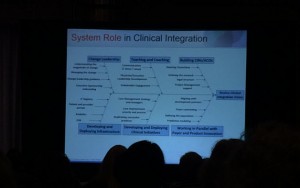It was a privilege to attend the Fourteenth Population Health Colloquium in Philadelphia starting on a snowy St. Patrick’s Day. One of my favorite sessions on Monday afternoon was led by Terry O’Rourke, MD who postponed his celebration of the holiday to present “Managing Populations: The Role of a Large Health System.” CHE Trinity as a healthcare organization treats 18 million patients a year and Dr. O’Rourke had a great  perspective on the challenges of population health management.
perspective on the challenges of population health management.
Dr. O’Rourke stated that CHE Trinity was one of the largest home care providers in the United States and that their healthcare organization encompassed 86 hospitals and 21,600 physicians. More importantly, CHE Trinity was participating in 6 bundled payment programs and 29 patient centered medical home programs. His observation that “All Healthcare is Local, All Healthcare Standards are National” comes from an understanding of the need for clinically integrated networks and the role of data driven decision making in reducing variations in outcomes. Terry noted that despite hard work on adopting standards that there is still a wide variation in healthcare delivery. He also noted that the lesser but still significant variation in outcomes across a large healthcare organization was more proof of the resiliency of human body than the careful adoption of standardized procedures.
The key to his presentation was the observation that clinicians need to lead the effort to standardize care, not hospital administrations or others. CHE Trinity created a unified clinical organization with the help of outside consultants that streamlined many silos within the large organization into a whole unit. As a result of unifying the clinical organization, Dr. O’Rourke noted that operating cash flow margins improved to 9.4 – 9.6% across the system. The second step beyond unification was to improve their reporting to encourage data driven decision-making. It was interesting to see how the metrics were converted into grades, like school grades, for easy consumption and judging performance. The different  hospital boards had GPAs ranging from a low of 2.1 to a high of 3.6 on a 4 point scale. The goal of the data-driven decision support process was to improve the ease of consuming and acting on the information.
hospital boards had GPAs ranging from a low of 2.1 to a high of 3.6 on a 4 point scale. The goal of the data-driven decision support process was to improve the ease of consuming and acting on the information.
To summarize, Dr. O’Rourke said that “good care is cost effective care.” Clearly, CHE Trinity is focused on bringing a level of consistency in clinical procedures in population health management and improving cash flow margins in the process. As with most organizational business solutions, the focus on people and process yields the best results with technology playing a supporting role was my observation. The focus on people, patients, as the central figure in their clinical processes is real population health management.
